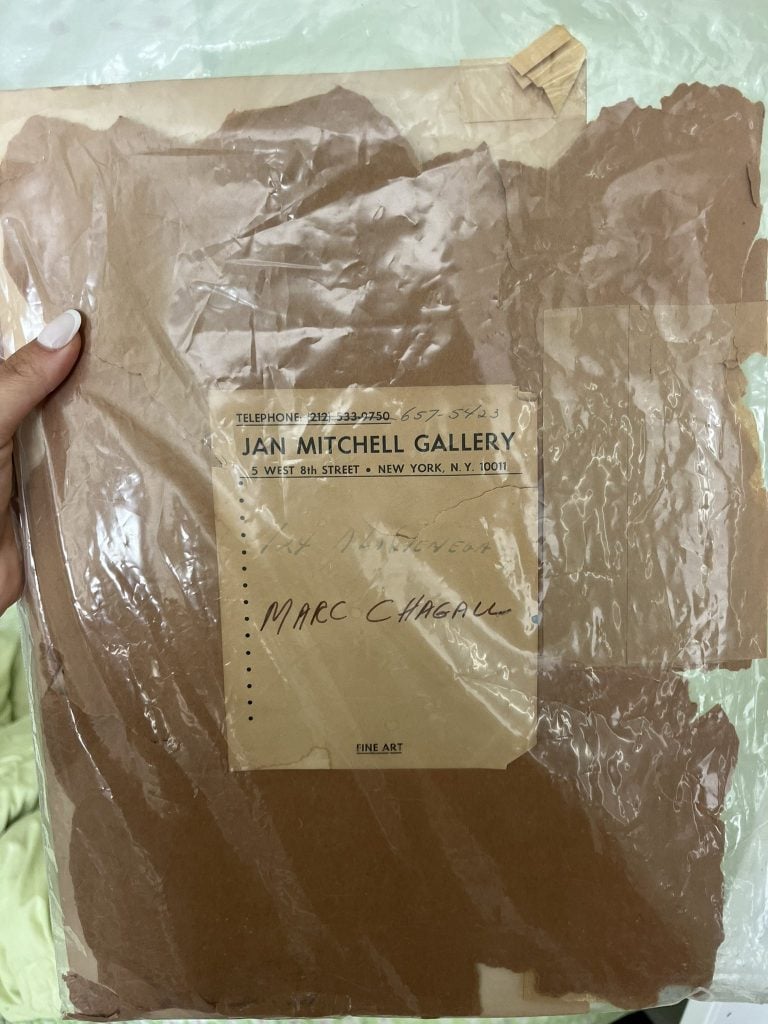Art World
A College Student Paid $2 For an Artwork at an Estate Sale. Is It a $20,000 Chagall?
It may not look like his more familiar images, but she thinks she scored an original.

It’s every art lover’s dream to find something for a few bucks that turns out to be worth a lot more, and one California student is saying she’s living the dream as we speak.
“Just found out this random oil pastel I bought secondhand for like $2 is a Chagall and worth at least like $20,000,” read a post on X by Shannon Kim, followed by a string of laugh-cry emojis. She turned the piece up at an estate sale in Orange County, California.
“It was in a giant pile of posters, all priced at $1 or $2,” she said. “It seemed like the people who lived there were art fans, because there were posters hanging everywhere in addition to artworks. I looked closely at the back and I saw it said Chagall and I was like, ‘Marc Chagall, are you serious?’”
She also noted a vintage-looking label on the back from Jan Mitchell Gallery, of 5 West 8th Street, New York, suggesting that it might be the real deal. She brought it to a family friend who works at Christie’s and, spotting a signature, weighed in informally, saying it’s authentic and offering a $20,000 valuation.
The piece may not look much like the Chagall who is familiar from dorm-room posters and auction blocks alike (where his high stands at $28.5 million, set by his 1928 canvas Les Amoureux at Sotheby’s New York in 2017). The Belarusian-French artist is better known for whimsical canvases depicting peasant life, including subjects like the circus, lovers flying together above villages, and animals, all inspired by dimensions of the artist’s and his family’s history.

The verso of Shannon Kim’s possible Chagall. Courtesy Shannon Kim.
Kim’s more abstract acquisition, by contrast, is marked by a bold red X with a small yellow shape at its center, all against a pink background, with a number of abstract, calligraphy-like black strokes throughout.
Not everyone was buying her attribution of the work, with one commenter snarkily commenting, “What is remotely Chagall about this work.”
“A lot of it!” replied Kim, with a smiley. “Even though he’s mostly known for pastoral cubist surrealism… in the ’50s he did a lot of oil pastels with long character-like brush strokes as you can see in mine and brighter more vibrant use of pastels.” To support her case, she offers his Bouquet a la Main (1957) as an example, which does indeed bear some similarities to her work.
While she is a political economy major, she also has a YouTube page with a few thousand subscribers where she offers lectures on cultural subjects ranging from Pop artist Marisol to Chinese calligraphy to a Nietzschean critical analysis of The Lego Movie.
Kim has no plans to cash in on her find.
“I didn’t buy it because I thought it was a Chagall,” Kim said. “I just picked it up because I thought it was a really beautiful piece of work.”





